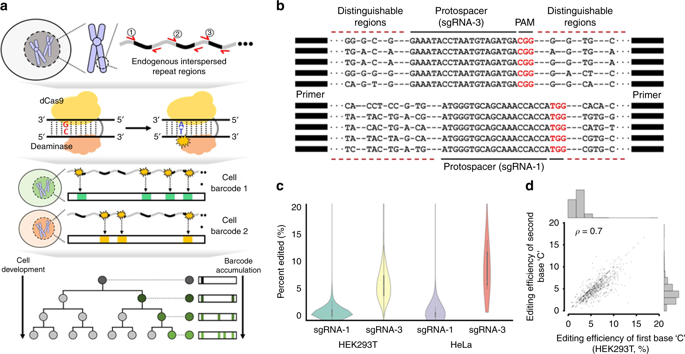Nature Communications ( IF 14.7 ) Pub Date : 2019-03-15 , DOI: 10.1038/s41467-019-09203-z Byungjin Hwang 1 , Wookjae Lee 1 , Soo-Young Yum 2 , Yujin Jeon 1 , Namjin Cho 1 , Goo Jang 2 , Duhee Bang 1

|
Determining cell lineage and function is critical to understanding human physiology and pathology. Although advances in lineage tracing methods provide new insight into cell fate, defining cellular diversity at the mammalian level remains a challenge. Here, we develop a genome editing strategy using a cytidine deaminase fused with nickase Cas9 (nCas9) to specifically target endogenous interspersed repeat regions in mammalian cells. The resulting mutation patterns serve as a genetic barcode, which is induced by targeted mutagenesis with single-guide RNA (sgRNA), leveraging substitution events, and subsequent read out by a single primer pair. By analyzing interspersed mutation signatures, we show the accurate reconstruction of cell lineage using both bulk cell and single-cell data. We envision that our genetic barcode system will enable fine-resolution mapping of organismal development in healthy and diseased mammalian states.
中文翻译:

使用针对内源性 L1 元件的 Cas9 脱氨酶条形码系统进行谱系追踪
确定细胞谱系和功能对于理解人类生理学和病理学至关重要。尽管谱系追踪方法的进步为细胞命运提供了新的见解,但在哺乳动物水平上定义细胞多样性仍然是一个挑战。在这里,我们开发了一种基因组编辑策略,使用与切口酶 Cas9 (nCas9) 融合的胞苷脱氨酶来特异性靶向哺乳动物细胞中的内源性散布重复区域。由此产生的突变模式充当遗传条形码,它是通过单引导 RNA (sgRNA) 的定向诱变、利用替换事件诱导的,随后由单个引物对读出。通过分析分散的突变特征,我们展示了使用大量细胞和单细胞数据准确重建细胞谱系。我们设想,我们的遗传条形码系统将能够对健康和患病哺乳动物状态的有机体发育进行高分辨率绘图。






























 京公网安备 11010802027423号
京公网安备 11010802027423号